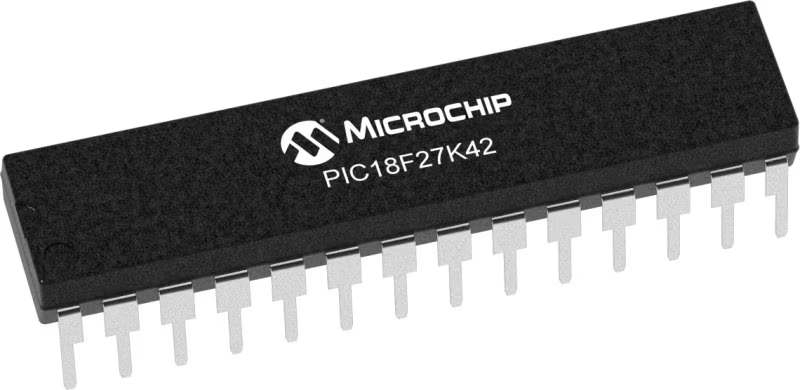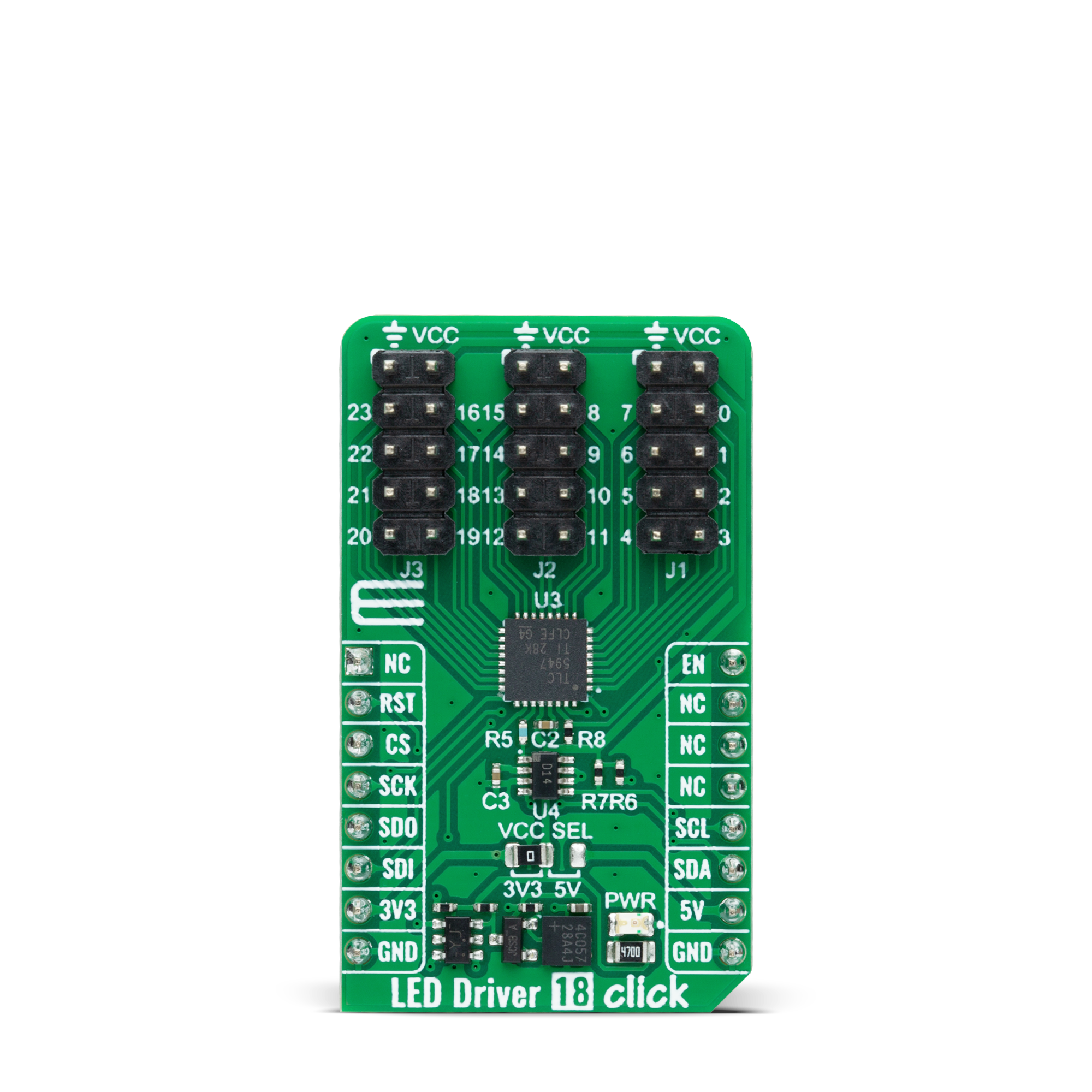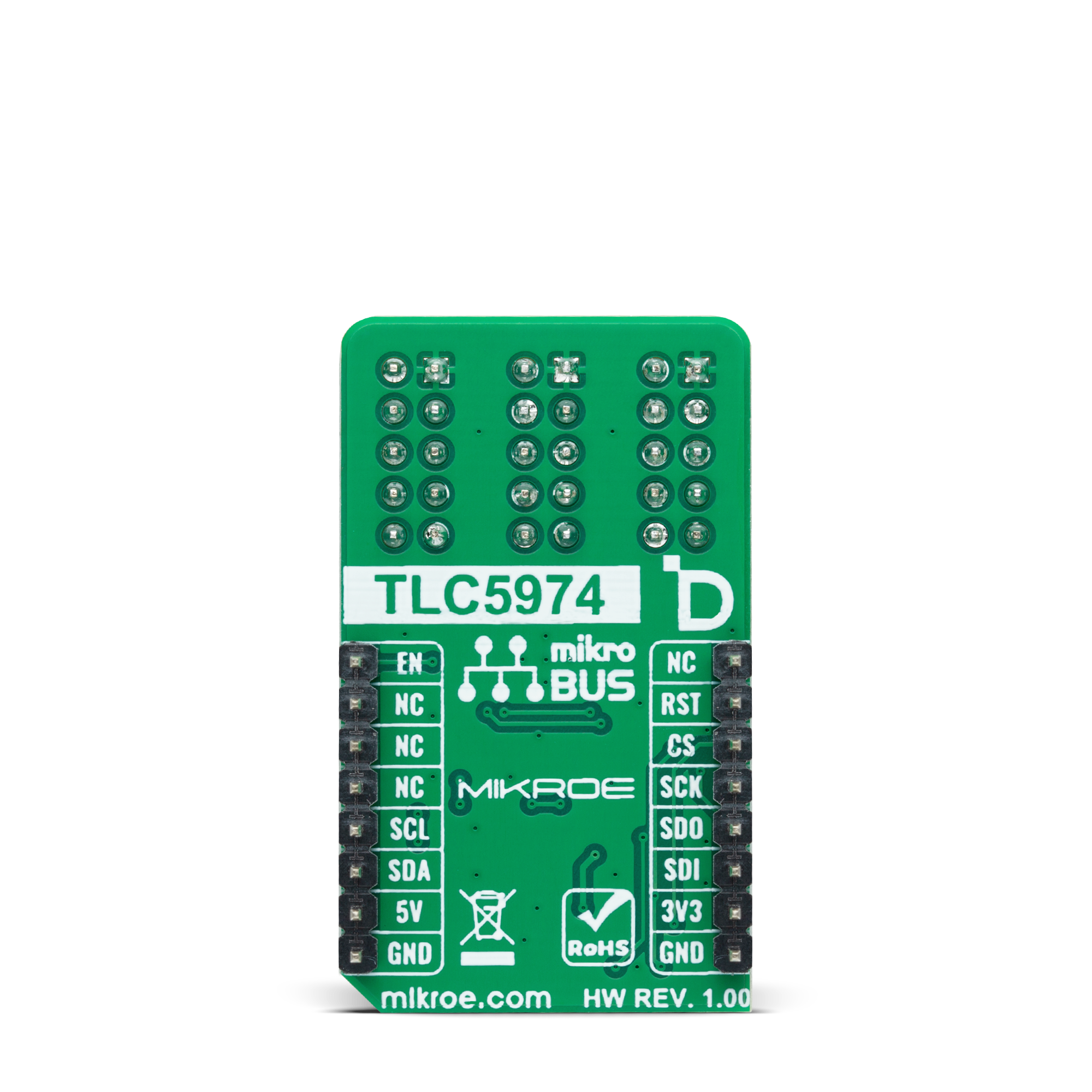相信我们可靠且创新的 LED 驱动解决方案,它能为您的照明项目注入活力,为您的所有 LED 照明需求提供无与伦比的性能和效率。
A
A
硬件概览
它是如何工作的?
LED Driver 18 Click 基于 TLC5947,这是来自德州仪器的 24 通道 12 位 PWM LED 驱动器。每个通道支持多个串联连接到 LED 端子的 LED,并通过串行接口端口具有可单独调节的 4096 步 PWM 灰度亮度控制。所有 24 个通道的可编程电流值通过 AD5171(一种 I2C 可配置的数字电位器)实现,每个通道的最大 LED 电流为 30mA。TLC5947 还具有内置的热关断功能,在过温条件下关闭所有输出驱动
器。当温度恢复正常时,所有通道自动重新启动。LED Driver 18 Click 通过寄存器可选择的标准 SPI 接口与 MCU 通信,支持高达 30MHz 的高时钟速度以获得最佳性能。除了接口信号外,TLC5947 还使用 mikroBUS™ 插座的另一个信号。路由到 mikroBUS™ 插座的 EN 引脚的使能信号提供关闭所有恒流输出的能力。当 EN 引脚处于高电平状态时,所有通道(0-23)被强制关闭,灰度 PWM 计时控
制器初始化,灰度计数器复位为 0。当 EN 引脚处于低电平状态时,灰度 PWM 计时控制器控制所有 LED 通道。此 Click board™ 可以在 3.3V 或 5V 逻辑电压水平下运行,通过 VCC SEL 跳线选择。这样,3.3V 和 5V 的 MCU 都可以正确使用通信线路。此外,该 Click board™ 配备了包含易于使用的函数和示例代码的库,可作为进一步开发的参考。
功能概述
开发板
EasyPIC v8 是一款专为快速开发嵌入式应用的需求而特别设计的开发板。它支持许多高引脚计数的8位PIC微控制器,来自Microchip,无论它们的引脚数量如何,并且具有一系列独特功能,例如首次集成的调试器/程序员。开发板布局合理,设计周到,使得最终用户可以在一个地方找到所有必要的元素,如开关、按钮、指示灯、连接器等。得益于创新的制造技术,EasyPIC v8 提供了流畅而沉浸式的工作体验,允许在任何情况下、任何地方、任何时候都能访问。
EasyPIC v8 开发板的每个部分都包含了使同一板块运行最高效的必要组件。除了先进的集成CODEGRIP程 序/调试模块,该模块提供许多有价值的编程/调试选项和与Mikroe软件环境的无缝集成外,该板还包括一个干净且调节过的开发板电源供应模块。它可以使用广泛的外部电源,包括电池、外部12V电源供应和通过USB Type-C(USB-C)连接器的电源。通信选项如USB-UART、USB DEVICE和CAN也包括在内,包括 广受好评的mikroBUS™标准、两种显示选项(图形和
基于字符的LCD)和几种不同的DIP插座。这些插座覆盖了从最小的只有八个至四十个引脚的8位PIC MCU的广泛范围。EasyPIC v8 是Mikroe快速开发生态系统的一个组成部分。它由Mikroe软件工具原生支持,得益于大量不同的Click板™(超过一千块板),其数量每天都在增长,它涵盖了原型制作和开发的许多方面。
微控制器概述
MCU卡片 / MCU

建筑
PIC
MCU 内存 (KB)
128
硅供应商
Microchip
引脚数
28
RAM (字节)
8192
使用的MCU引脚
mikroBUS™映射器
“仔细看看!”
Click board™ 原理图

一步一步来
项目组装
实时跟踪您的结果
应用程序输出
此款Click板可通过两种方式进行接口连接和监控:
Application Output- 在调试模式下,使用“Application Output”窗口进行实时数据监控。按照本教程正确设置它。
UART Terminal- 通过UART终端使用USB to UART converter监控数据有关详细说明,请查看本教程。
软件支持
库描述
该库包含 LED Driver 18 Click 驱动程序的 API。
关键功能:
leddriver18_set_output_pwm- LED Driver 18 设置输出通道 PWM 值功能leddriver18_write_config- LED Driver 18 写入配置功能leddriver18_set_cc_output- LED Driver 18 设置恒流输出功能
开源
代码示例
完整的应用程序代码和一个现成的项目可以通过NECTO Studio包管理器直接安装到NECTO Studio。 应用程序代码也可以在MIKROE的GitHub账户中找到。
/*!
* @file main.c
* @brief LED Driver 18 Click example
*
* # Description
* This library contains API for LED Driver 18 Click driver.
* The library initializes and defines the I2C bus drivers to
* write and read data for setting constant current output,
* as well as the default configuration for a PWM output value
* of the OUT pins.
*
* The demo application is composed of two sections :
*
* ## Application Init
* Initializes the driver and performs default configuration and sets
* the device in output enabled mode.
*
* ## Application Task
* This example demonstrates the use of the LED Driver 18 Click board by
* changing PWM values for all output from a minimum value to
* maximum value and back to minimum controlling the brightness of the
* LEDs in the process.
*
* @author Stefan Ilic
*
*/
#include "board.h"
#include "log.h"
#include "leddriver18.h"
static leddriver18_t leddriver18;
static log_t logger;
void application_init ( void )
{
log_cfg_t log_cfg; /**< Logger config object. */
leddriver18_cfg_t leddriver18_cfg; /**< Click config object. */
/**
* Logger initialization.
* Default baud rate: 115200
* Default log level: LOG_LEVEL_DEBUG
* @note If USB_UART_RX and USB_UART_TX
* are defined as HAL_PIN_NC, you will
* need to define them manually for log to work.
* See @b LOG_MAP_USB_UART macro definition for detailed explanation.
*/
LOG_MAP_USB_UART( log_cfg );
log_init( &logger, &log_cfg );
log_info( &logger, " Application Init " );
// Click initialization.
leddriver18_cfg_setup( &leddriver18_cfg );
LEDDRIVER18_MAP_MIKROBUS( leddriver18_cfg, MIKROBUS_1 );
if ( I2C_MASTER_ERROR == leddriver18_init( &leddriver18, &leddriver18_cfg ) )
{
log_error( &logger, " Communication init." );
for ( ; ; );
}
if ( LEDDRIVER18_ERROR == leddriver18_default_cfg ( &leddriver18 ) )
{
log_error( &logger, " Default configuration." );
for ( ; ; );
}
log_info( &logger, " Application Task " );
}
void application_task ( void )
{
float pwm_val;
for ( int8_t n_cnt = 0; n_cnt <= 100; n_cnt += 10 )
{
for ( uint8_t out_cnt = 0; out_cnt < LEDDRIVER18_MAX_OUTPUT_NUM; out_cnt++ )
{
leddriver18_set_output_pwm( out_cnt, n_cnt );
}
pwm_val = leddriver18_get_output_pwm( 0 );
log_printf( &logger, " PWM value: %.2f \r\n", pwm_val );
leddriver18_write_config( &leddriver18 );
Delay_ms( 200 );
}
for ( int8_t n_cnt = 100; n_cnt >= 10; n_cnt -= 10 )
{
for ( uint8_t out_cnt = 0; out_cnt < LEDDRIVER18_MAX_OUTPUT_NUM; out_cnt++ )
{
leddriver18_set_output_pwm( out_cnt, n_cnt );
}
pwm_val = leddriver18_get_output_pwm( 0 );
log_printf( &logger, " PWM value: %.2f \r\n", pwm_val );
leddriver18_write_config( &leddriver18 );
Delay_ms( 200 );
}
}
void main ( void )
{
application_init( );
for ( ; ; )
{
application_task( );
}
}
// ------------------------------------------------------------------------ END


































